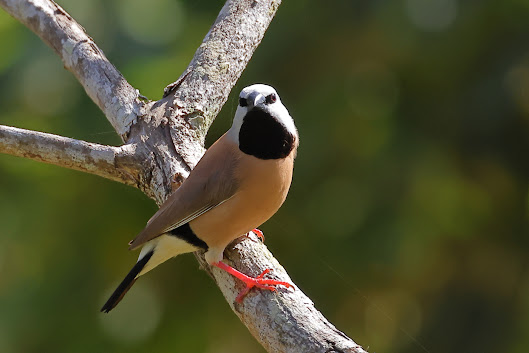 Rufous Songlark... shows up after three weeks without being sighted
Rufous Songlark... shows up after three weeks without being sighted
Many birders will understand that terrible dread of letting down a visitor to one's stamping ground.
Having written or otherwise played up the rare treasures within, one's left saying, 'Well, they were here yesterday.'
So it's with some relief to report that a southern visitor shared in most of the 68 birds ticked off today before a localised front bucketed down - on me alone. The visitor got out beforehand. Sitting on 68, I decided to crack on for 70+ and ended drenched and still on 68.
But (always a but), didn't find Grey Whistler, or White-browed Crake, or any much less likely Lovely Fairy Wrens.
Best in the air: dark Swamp Harrier, maturing White-bellied Sea Eagle, Pelican, Little Black Cormorant, and (all to myself, BV before visitor) 9 Red-tailed Black Cockatoos (heading north: nothing in Tyto appeals to them).
In the trees (some on visitor's wish list): White-gaped Honeyeater, White-browed Robin, Rufous Fantail, Northern Fantail, MacLeays, Dusky, Graceful and Brown-backed Honeyeaters. Also sightings of Brush and Fan-tailed Cuckoos with caterpillars.
On or over the water: Little, Azure Kingfishers, juvenile Black-necked Stork, White-necked Heron. Water Python nosing about at water side of bulrushes, but no clear view.
About four hours of spotting and conversation, dealing, of course, largely with birds and wildlife. Enjoyable as a change, though at end of the joint bike ride, not a photograph taken. Obsessive single-mindedness is modified in company.
It had paid off before the joint effort as I patrolled my 2ha listing segment. Two puzzling birds engaged in distant hectic chasing through and around a grove resolved their differences and plonked themselves close to me: the 'vanished' Rufous Songlark and a young Horsfield's Cuckoo. Hadn't seen songlark for almost three weeks. Suddenly it's on top of me! Picture. Best (and only bird) of the day, but, sadly, BV.
 Latham's Snipe (Gallinado hardwickii) pictured at high noon today standing quietly at the edge of a treatment pond. Sorry about the harsh light. Don't have flash capable of infill.
Latham's Snipe (Gallinado hardwickii) pictured at high noon today standing quietly at the edge of a treatment pond. Sorry about the harsh light. Don't have flash capable of infill.


















